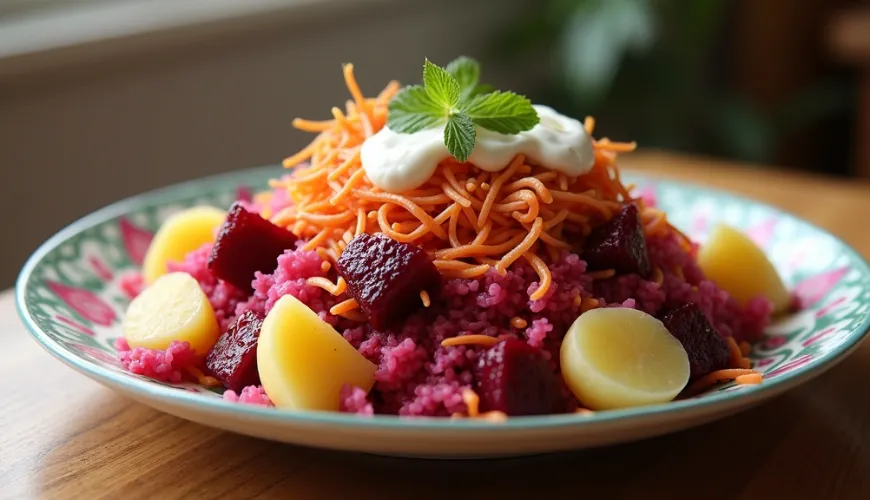
Shuba Recipe - A Layered Salad Full of Memories and Great Flavors

Šuba - A Colorful Salad with History You'll Love
At first glance, it may resemble a piece of art — layers of vibrant colors, precisely arranged one atop the other, so appealing that you hesitate to take the first bite. Yet, it is one of the most famous celebratory dishes of post-Soviet cuisine. We are talking about the traditional salad known as šuba, or sleděj pod šubou – herring under a fur coat. Its origins trace back to the territory of today's Ukraine and Russia, but it is also well-known in most states of the former Soviet Union.
In recent years, šuba – often spelled as “shuba” – has enjoyed renewed popularity beyond Eastern Europe. People are rediscovering it not only as a nostalgic memory of childhood but also as an unconventional alternative to French salad or classic potato salad. Its uniqueness lies in the combination of sweet, sour, salty, and mild flavors in a single bite. And that is precisely its charm.
How Did the Šuba Salad Originate and Why Does It Have a "Coat"?
Layer by layer, color by color — šuba not only has a distinctive taste but also an aesthetic. The traditional recipe requires grated beetroot, potatoes, carrots, onion, and pickled herring. All of this is layered and interspersed with mayonnaise. The result is a hearty, nutritious salad that graces the festive table, especially on New Year's.
The nickname "under a fur coat" (or "šuba") came about because of the layer of beetroot that covers the entire salad, resembling a warm winter coat. In the past, the salad symbolized the ingenious combination of simple ingredients, which could create something extraordinary – a common theme in Soviet households.
Although šuba has its roots in Eastern Europe, the Ukrainian and Russian versions are not much different. In both cases, it is a festive dish that emerged as an expression of creativity during times when the selection of ingredients was limited.
Traditional Recipe for Šuba
If you're tempted to try something new and yet simple, you can prepare šuba at home. There are many variations – some replace herring with smoked fish or even eggs, others add apple for freshness. However, here we present the classic recipe for šuba, as known in Ukraine.
Ingredients (for 6 people):
- 2 herring fillets (preferably marinated in oil or brine)
- 3 medium potatoes
- 2 larger beets
- 2 carrots
- 1 small onion
- 3–4 tablespoons of mayonnaise (a plant-based version can also be used)
- Salt and pepper to taste
- Optional: apple, hard-boiled egg, dill for garnish
Instructions:
- Boil the vegetables in their skins – beetroot, carrot, and potatoes. After boiling, let them cool and peel.
- Cut the herring into small pieces and spread it as the first layer at the bottom of a glass bowl or cake form.
- Finely chop the onion, optionally blanch with hot water to reduce sharpness, and place it on the herring.
- Grate the boiled potatoes and press them as the next layer. Lightly salt.
- Add a layer of grated carrot and spread mayonnaise over it.
- Grate the beetroot, evenly distribute it, and again spread mayonnaise over it.
- Let the salad sit for several hours (ideally overnight) in the refrigerator to allow the flavors to meld.
The result is a hearty yet refreshing salad with a unique visual structure. Its layering is not only eye-catching but also practical – each bite offers a different combination of flavors.
Why Is Šuba More Than Just a Salad?
You might wonder: why should a salad of beetroot and fish evoke so many emotions? The answer lies not only in the taste but also in memories and the social context. In many Eastern European households, šuba is an inseparable part of celebrations. It is prepared with care, patience, and a certain amount of pride.
For instance, in Ukraine, šuba is traditionally served on New Year's Eve along with other dishes such as vareniki or kutia. In families observing Orthodox traditions, šuba is often one of the first dishes tasted after the Christmas fast. In Russia, it is common for the salad to stand alongside the famous "Olivier" salad – their version of potato salad.
One woman who grew up in Kyiv in the 1980s recalls: "When mom was making šuba, no one was allowed in the kitchen. Each layer had to be perfect, each had its meaning. And when it was done, we couldn't eat it right away – it had to 'mature.' And then it was the greatest reward."
Vegetarian or Modern Šuba? Yes, It's Possible
Although traditional šuba is incomplete without herring, more and more people prefer plant-based alternatives – and surprisingly, it's not difficult at all. Herring can easily be replaced with baked mushrooms, smoked tofu, red lentils, or even marinated eggplant, and the result is surprisingly tasty.
While the taste changes, the layering and basic structure remain intact. Šuba thus can be a great alternative for vegetarians and vegans. Plant-based mayonnaise can also be easily made at home from aquafaba (chickpea water), allowing even those with allergies to enjoy this delicacy without worries.
An interesting variation is also serving šuba in individual glasses or as small dessert rounds – an elegant way to offer it at parties or festive receptions.
Culinary Bridges Between Cultures
Today, the recipe for šuba spreads across the internet under various names: "Ukrainian šuba recipe," "Russian šuba recipe," "šuba salad recipe," or simply "recipe for šuba." And although the names differ, the foundation remains the same – the combination of beetroot, potatoes, and mayonnaise in a festive form.
It's fascinating how this dish transforms depending on the country where it's prepared. In Lithuania, sour cream is often added, while in Moldova, more garlic is used. In the Czech Republic, people have taken a liking to šuba primarily as an unconventional treat that combines familiar ingredients with new taste sensations.
It's intriguing how a single salad can connect so many different cultures. At a time when the world is polarizing and traditional recipes sometimes fall into oblivion, šuba is proof that even ordinary food can carry history, story, and emotions.
After all, as the famous Ukrainian chef Oleh Skrypka says: "Šuba is like grandma's quilt – made of different pieces, but together it creates something warm and familiar." And that's why it has its place on the modern table – whether you're celebrating Christmas, New Year's, or simply have a craving for something extraordinary.

